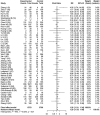Why do men have worse COVID-19-related outcomes? A systematic review and meta-analysis with sex adjusted for age
- PMID: 35195196
- PMCID: PMC8856598
- DOI: 10.1590/1414-431X2021e11711
Why do men have worse COVID-19-related outcomes? A systematic review and meta-analysis with sex adjusted for age
Abstract
We aimed to study the mechanism behind worse coronavirus disease-19 (COVID-19) outcomes in men and whether the differences between sexes regarding mortality as well as disease severity are influenced by sex hormones. To do so, we used age as a covariate in the meta-regression and subgroup analyses. This was a systematic search and meta-analysis of observational cohorts reporting COVID-19 outcomes. The PubMed (Medline) and Cochrane Library databases were searched. The primary outcome was COVID-19-associated mortality and the secondary outcome was COVID-19 severity. The study was registered at PROSPERO: 42020182924. For mortality, men had a relative risk of 1.36 (95%CI: 1.17 to 1.59; I2 63%, P for heterogeneity <0.01) compared to women. Age was not a significant covariate in meta-analysis heterogeneity (P=0.393) or subgroup analysis. For disease severity, being male was associated with a relative risk of 1.29 (95%CI: 1.19 to 1.40; I2 48%, P for heterogeneity <0.01) compared to the relative risk of women. Again, age did not influence the outcomes of the meta-regression (P=0.914) or subgroup analysis. Men had a higher risk of COVID-19 mortality and severity regardless of age, decreasing the odds of hormonal influences in the described outcomes.
Figures
References
-
- Jotz GP, Stein A, Sirena S, Barros E, Baldisserotto J, de Figueiredo JAP, et al. The COVID-19 pandemic and planetary health. a critical review of epidemiology, prevention, clinical characteristics and treatments for oral, head and neck health professionals. Do we have a roadmap? Int Arch Otorhinolaryngol. 2020;24:e351–e358. doi: 10.1055/s-0040-1714143. - DOI - PMC - PubMed
-
- Harman SM, Metter EJ, Tobin JD, Pearson J, Blackman MR, Baltimore Longitudinal Study of Aging. Longitudinal effects of aging on serum total and free testosterone levels in healthy men. Baltimore longitudinal study of aging. J Clin Endocrinol Metab. 2001;86:724–731. doi: 10.1210/jcem.86.2.7219. - DOI - PubMed
Publication types
MeSH terms
LinkOut - more resources
Full Text Sources
Medical




